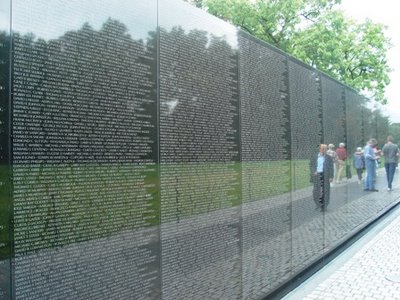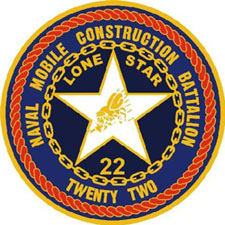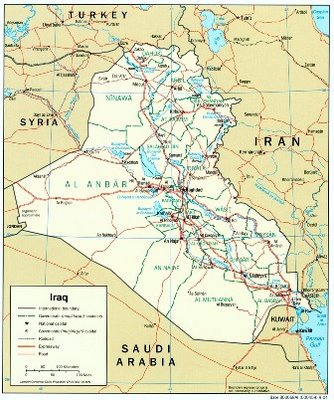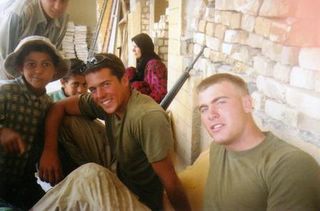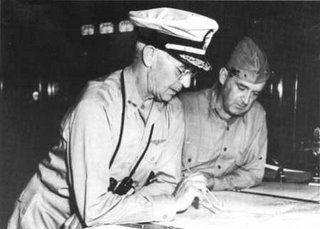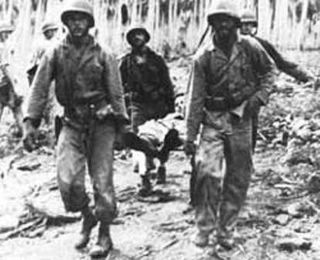Saturday, December 30, 2006
Blood Is Thicker Than Water: Guadalcanal, The Landing and August Battles*2
by Henry I. Shaw, Jr.
The Landing and August Battles
where we ended last time:.... Unfortunately, the division's heaviest ordnance had been left behind in New Zealand. Limited ships' space and time meant that the division's big guns, a 155mm howitzer battalion, and all the motor transport battalion's two-and-a-half-ton trucks were not loaded. Colonel Pedro A. del Valle, commanding the 11th Marines, was unhappy at the loss of his heavy howitzers and equally distressed that essential sound and flash-ranging equipment necessary for effective counterbattery fire was left behind. Also failing to make the cut in the battle for shipping space, were all spare clothing, bedding rolls, and supplies necessary to support the reinforced division beyond 60 days of combat. Ten days supply of ammunition for each of the division's weapons remained in New Zealand.
***
In the opinion of the 1st Division's historian and a veteran of the landing, the men on the approaching transports "thought they'd have a bad time getting ashore." They were confident, certainly, and sure that they could not be defeated, but most of the men were entering combat for the first time. There were combat veteran officers and noncommissioned officers (NCOs) throughout the division, but the majority of the men were going into their initial battle. The commanding officer of the 1st Marines, Colonel Clifton B. Cates, estimated that 90 percent of his men had enlisted after Pearl Harbor. The fabled 1st Marine Division of later World War II, Korean War, Vietnam War, and Persian Gulf War fame, the most highly decorated division in the U.S. Armed Forces, had not yet established its reputation.
The convoy of ships, with its outriding protective screen of carriers, reached Koro in the Fiji Islands on 26 July. Practice landings did little more than exercise the transports' landing craft, since reefs precluded an actual beach landing. The rendezvous at Koro did give the senior commanders a chance to have a face-to-face meeting. Fletcher, McCain, Turner, and Vandegrift got together with Ghormley's chief of staff, Rear Admiral Callaghan, who notified the conferees that ComSoPac had ordered the 7th Marines on Samoa to be prepared to embark on four days notice as a reinforcement for Watchtower. To this decidedly good news, Admiral Fletcher added some bad news. In view of the threat from enemy land-based air, he could not "keep the carriers in the area for more than 48 hours after the landing." Vandegrift protested that he needed at least four days to get the division's gear ashore, and Fletcher reluctantly agreed to keep his carriers at risk another day.
On the 28th the ships sailed from the Fijis, proceeding as if they were headed for Australia. At noon on 5 August, the convoy and its escorts turned north for the Solomons. Undetected by the Japanese, the assault force reached its target during the night of 6-7 August and split into two landing groups, Transport Division X-Ray, 15 transports heading for the north shore of Guadalcanal east of Lunga Point, and Transport Division Yoke, eight transports headed for Tulagi, Gavutu, Tanambogo, and the nearby Florida Island, which loomed over the smaller islands.
1 of 2
Blood Is Thicker Than Water: Guadalcanal, The Landing and August Battles *3
As the ships slipped through the channels on either side of rugged Savo Island, which split Sealark near its western end, heavy clouds and dense rain blanketed the task force. Later the moon came out and silhouetted the islands. On board his command ship, Vandegrift wrote to his wife: "Tomorrow morning at dawn we land in our first major offensive of the war. Our plans have been made and God grant that our judgement has been sound ... whatever happens you'll know I did my best. Let us hope that best will be good enough."
At 0641 on 7 August, Turner signalled his ships to "land the landing force." Just 28 minutes before, the heavy cruiser Quincy (CA-39) had begun shelling the landing beaches at Guadalcanal. The sun came up that fateful Friday at 0650, and the first landing craft carrying assault troops of the 5th Marines touched down at 0909 on Red Beach. To the men's surprise (and relief), no Japanese appeared to resist the landing. Hunt immediately moved his assault troops off the beach and into the surrounding jungle, waded the steep-banked Ilu River, and headed for the enemy airfield. The following 1st Marines were able to cross the Ilu on a bridge the engineers had hastily thrown up with an amphibian tractor bracing its middle. The silence was eerie and the absence of opposition was worrisome to me riflemen. The Japanese troops, most of whom were Korean laborers, had fled to the west, spooked by a week's B-17 bombardment, the pre-assault naval gunfire, and the sight of the ships offshore. The situation was not the same across Sealark. The Marines on Guadalcanal could hear faint rumbles of a firefight across the waters.
The Japanese on Tulagi were special naval landing force sailors and they had no intention of giving up what they held without a vicious, no-surrender battle. Edson's men landed first, followed by Rosecrans' battalion, hitting Tulagi's south coast and moving inland towards the ridge which ran lengthwise through the island. The battalions encountered pockets of resistance in the undergrowth of the island's thick vegetation and maneuvered to outflank and overrun the opposition. The advance of the Marines was steady but casualties were frequent. By nightfall, Edson had reached the former British residency overlooking Tulagi's harbor and dug in for the night across a hill that overlooked the Japanese final position, a ravine on the island's southern tip. The 2d Battalion, 5th Marines, had driven through to the northern shore, cleaning its sector of enemy; Rosecrans moved into position to back up the raiders. By the end of its first day ashore, 2d Battalion had lost 56 men killed and wounded; 1st Raider Battalion casualties were 99 Marines.
to be continued or read more now: source
Good News
Marines receive increase in BAH
Cpl. Brian Reimers
New rates allotted to Camp Pendleton Marines for housing allowances were recently released and with significant increases in dollar amounts. Marines can see the changes take effect Jan. 1, 2007. An average of 4.5 to 6 percent increase throughout the ranks is helping Camp Pendleton Marines living off base pay less out-of-pocket costs for rent...
Photo of the Day: Boots & Rubble
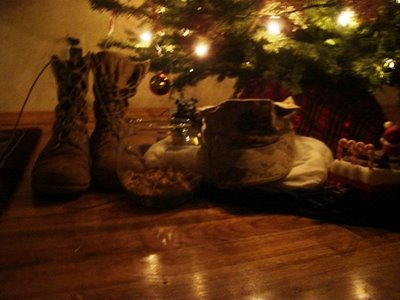 If they could talk.... These are Aaron's boots from OIF 1, a bulldog with his name, DOB, DOD, and KIA Vigilant Resolve inscribed on it, and his cap from OIF 2 atop my snuggle pillow: the pillow Aaron and I argued over and I ended up sending to him in Iraq.
If they could talk.... These are Aaron's boots from OIF 1, a bulldog with his name, DOB, DOD, and KIA Vigilant Resolve inscribed on it, and his cap from OIF 2 atop my snuggle pillow: the pillow Aaron and I argued over and I ended up sending to him in Iraq. He got the pillow right after 2/1 lost 2 on April 12, 2004.
The pillow my son held so desperately that night, I cling to every night now.
And up front, Doc, Sgt. Rett, is some of the sand and rubble where 2/1 walked, fought, killed, and died a little bit themselves that day. It is the sand and rubble Steve brought back to me from the site where Aaron was hit.
I gathered it tonight for you both. Arranged it as if it were my heart.
I wish I could get closer to share it with you. I will never be able to repay either one of you for the love you shared with my son, for the pain brought into your own lives that day; I can't give back much of anything. But I love you both so much. I know more than a few fought to save my baby on that day, but somehow, you two have returned to me, and remain beside me as much as is possible ... while we heal.
God bless you both and keep you safe. May He make your heart light when it should be and heavy at times as well. May He never take His eye off you or His Spirit from you.
God be with each of you on your journeys and give you strength and boldness to complete that which He purposed you for.
Semper Fi,
De'on
Some Thoughts
I came across the following list that was used in some instruction I received from the company. Good stuff.
1. Sometimes the best management is no management at all -- first do no harm!
2. Indifference is as important as passion.
3. In organizational life, you can have influence over others or you can have freedom from others, but you can't have both at the same time.
4. Learning how to say smart things and give smart answers is important. Learning to listen to others and to ask smart questions is more important.
5. You get what you expect from people. This is especially true when it comes to selfish behavior; self-interest is a learned social norm, not an inherent feature of human behavior.
6. Getting a little power can turn you into an insensitive self-centered jerk.
7. Avoid pompous jerks whenever possible. They not only can make you feel bad about yourself, chances are that you will eventually start acting like them.
8. The best test of a person's character is how he or she treats those with less power.
9. Err on the side of optimism and positive energy in all things.
10. Work is an over-rated activity.
Virgie Bell's View
I posted a view not long ago about Allen’s difference and defiance in all things political or news-worthy. I wondered what had become of the even-tempered Allen. After last night on hearing his defiance toward our military handing over Saddam to the Iraq government for hanging, I was amazed at his attitude of personal injury and righteousness of his view. I have become used to him defending O.J. and the accuser in the Duke rape case, and just about anything my snit is against, his snit is for. I concede and to him goes the victory. Allen Colmes is the winner. The last battle fought by me with my T.V. and Allen was last night as the world was awaiting the hanging of the Butcher of Baghdad.
I have to admit Colmes won by a knock-out as far as snits go. I nearly got down on my knees to ask forgiveness that I ever harbored ill will toward O.J. or Cindy Sheehan. But as the readers of Gunz-up have now been able to observe, I am the crazy old aunt locked in the attic as far as this blog is concerned. I cannot say I have ever risked my life or limb for my country or other glorious achievement. In fact, Kayla and I stand alone as contributors to this blog when it comes to military service. We have never been on a battlefield with first hand knowledge of achievement. In all things military and every political opinion pro or con, if some of us don't agree with those who disagree with us, we won't be speaking to one another by 2007, so that's my minefield, and I have not yet decided as to give it a go or not.
Allen Colmes was of the opinion that the U.S. government should have stepped in and stopped the hanging of Saddam. The U.S. military had Saddam in their custody therefore his death is on us? Pulleeez.
I know that Allen desperately wants a Democratic President next time; nonetheless, said news correspondent should honor the fact that Bush was duly elected to the office of the President by the citizens of the USA, and give up his concern with how stupid we of other opinions are. As far as I am concerned, I think O.J. Simpson got away with murder, Saddam Hussein was guilty of crimes against humanity...and Cindy Sheehan is ignorant as well. Unlike Mr. Colmes, I SUPPORT THE TROOPS.
P.S. Having just read in the internet headlines that democratic controlled congress plans to hold investigative hearings into whether Bush used manipulations to advance support for the public on the war on terror ... duh ... remember what happened on 9/11? I think I'll go watch Al Sharpton preach at the King of Soul’s funeral.... There they are: the Reverend Jesse Jackson, the Reverend Al Sharpton and Father of the Year, Michael Jackson. Democrats all.
Docs Duty: Snippets from NC Times.com Aug 2004
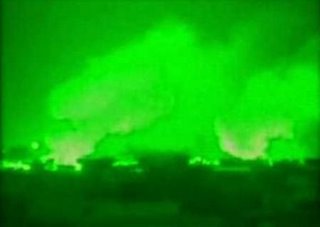
Marines recount Fallujah firefight
By: DARRIN MORTENSON - Staff Writer
"It was total chaos," said Navy Corpsman Jason Duty, 20, of New Concord, Ohio, one of the medics who pulled wounded men out of buildings and streets during the worst of the fighting. "It was just gunshots everywhere."
"They waited a few hours after we went in and then they attacked," said a stunned and angry Skiles several hours after the fighting Monday, staring off and shaking his head slowly from side to side as he repeated his words: "They waited, and then they attacked."
Duty and Skiles said the Marine killed and most of the wounded Monday were hit with shrapnel from grenades tossed by rebels into open windows. At least two of the Marines were also shot, said Duty, whose boots were black with the blood of his comrades as he recounted the fight.
Duty said he had to fire his pistol at gunmen just to get into the building where Marines lay bleeding, still fighting off insurgents, some of whom were only 10 yards away.
"I walk into a place like that -- everyone's down -- and you just don't know where to start," he said. "You just have to calm down and think, and then it all comes to you."
Skiles said Duty saved several of the Marines, and worked to save a fatally wounded Marine by continuing CPR in the back of a humvee as it sped through enemy fire over a jarring ride to a field hospital.... [this fatally wounded Marine, most of you know by now, was Aaron.]
Full Story
Docs Duty: Texas and Afghanistan
The night before the ceremony, I remember him sitting slightly across from me at a long table topped with the typical Texas red and white checkered BBQ cloth. Ribs, brisket and chicken, enough animal protein to cause PITA to pass out or Oprah to OPT out, was served on huge platters, passed up and over faces and around backs and between elbows of Marines and the family they were in Texas to pay tribute to. Sides included cole slaw, potatoe salad and more slaw. Not enough sides, well then, how about a side of beef? Slaughtered, dressed and packaged by morning.
This is Texas!
Aaron would've loved it.
Doc Duty and Sgt. Rett sat next to each other and had their food downed before I even got my plate. It tickled me then, and I was reminded of what my drills used to holler out in the chow hall at Basic Training, "Inhale, exhale, you should be through!"
It tickled me because they reminded me of Aaron. So full of life.
Hungry.
At times, I'd look toward those faces that I can picture so well right now, even at this late or early hour. It brings tears to my eyes as I remember the two, now as well as then, deep friends, brothers, laughing and joking and telling the tales of combat, and occassionally, blinking back tears.
I'm sure the moisture in their eyes was for their losses, their missing friends, and the huge family they now found themselves surrounded by, stealing glances at them. Marveling at them....
Currently, Hospital Corpsman 2nd Class Jason “Doc” Duty is with the Navy ETT (Embedded Training Team) 620A in Afghanistan. Doc has been at Camp Phoenix since Nov 15th 2006 and will be going home about the first of December 2007. It’s a year long tour.
When I asked Doc how this duty came about, he wrote, “I spent 3 1/2 years with Aaron's unit out in Camp Pendleton, and then transferred to the Corpsman school to be an instructor. During my time there, the Navy asked for experienced Corpsman to come here and train the ANA (afghan national army) medics. Me being experienced in Iraq and being an instructor, I was a shoe-in for the job.”
There are five Instructors at Camp Phoenix. They travel to the different ANA training camps and conduct classes for their medics there. Camp Phoenix in Kabul is Doc Duty’s "permanent" base for the next eleven months.
Doc is from New Concord, Ohio and has a four year old son he misses deeply. He’s served in the Navy for six years and his pay grade is E-5.
The next time we join Doc, we’ll look at some photos he emailed me of the work his unit is doing there. We’ll also get his take on one of the differences between the Iraqis and the Afghanis when it comes to fighting terror.
Until then, Cowboy, oops, I meant, Corpsman Up!
and
Semper Fi!
Docs Duty: Did You Know?
Join in. It'll be like school.
Doc, you let me know if there's something in here you DIDN'T know.
****
The hospital corps has, after a fashion, been a part of the United States Naval service since 1799 when a provision of congress was instituted service-wide to include a surgeon's assistant on all ships of the fleet.
The title of this specialty of training, also known as rating in naval terminology has changed over the years from loblolly boy, surgeon's steward, apothecary and bayman, the latter three all requiring the rate holder to be a recipient of some private medical instruction.
On 17 June 1898 by act of congress, the Hospital Corps was established, though the actual name of the servicemen under that rating would change several times (being known as "Pharmacist's Mates" throughout the World Wars) before ultimately becoming simply "Hospital Corpsman". The modern rating abbreviation is HM.
During World War I, there were 684 personal awards issued to Hospital Corpsmen, who distinguished themselves while serving with the United States Marines in numerous battles, among them Belleau Wood.
In World War II, Hospital Corpsmen hit the beach with the U.S. Marines in every battle in the Pacific. A Hospital Corpsman named John Bradley was among the group of Marines in the famous flag raising on Mt.Suribachi during the Battle of Iwo Jima. They also served on ships and submarines. They performed 14 unassisted appendectomies while in a submarine. The Hospital Corps has the distinction of being the only corps in the U.S. Navy to be singled out in a famous speech by Secretary of the Navy James Forrestal after the conclusion of World War II.
The Corpman's Oath
AND THESE WITNESSES
TO PRACTICE FAITHFULLY
ALL OF MY DUTIES AS A MEMBER OF
THE HOSPITAL CORPS.
I HOLD THE CARE OF THE SICK AND INJURED TO BE A
SACRED TRUST
AND WILL ASSIST THE MEDICAL OFFICER
WITH LOYALTY AND HONESTY.
I WILL NOT KNOWINGLY PERMIT HARM TO COME TO
ANY PATIENT.
I WILL NOT PARTAKE OF NOR ADMINISTER
ANY UNAUTHORIZED MEDICATION.
I WILL HOLD
ALL PERSONAL MATTERS
PERTAINING TO THE PRIVATE LIVES OF
PATIENTS IN STRICT CONFIDENCE.
I DEDICATE MY
HEART, MIND, AND STRENGTH
TO THE WORK BEFORE ME.
I SHALL DO ALL WITHIN MY POWER
TO SHOW IN MYSELF AN
EXAMPLE OF ALL THAT IS
HONORABLE AND GOOD
THROUGHOUT
MY NAVAL CAREER.
Docs Duty: A posting from Leatherneck in 2004
Submitted by: 1st Marine Division
Story Identification Number: 2004419104127
Story by Cpl. Shawn C. Rhodes
CAMP MAHMUDIYAH, Iraq (April 5, 2004) [21 days before Aaron is KIA]-- Navy Petty Officer 1st Class Barry C. Gibson makes life and death decisions every day. As 2nd Battalion, 2nd Marine Regiment's triage officer, he's the one charged with deciding which wounded Marines are treated first.
"A Marine might be expected to die when he arrives, but it's my decision to judge whether he's capable of walking, whether he goes to emergency surgery, or - based on his vital signs - if he can be saved," Gibson said.
Gibson has to make those sorts of decisions in just a matter of minutes, with a minimal examination. It's a tough responsibility and that was the reason the battalion recently held a mass casualty drill.
"This mass casualty drill is done to ensure the... battalion aid station, shock trauma platoon, and the forward resuscitative surgical system know their capabilities and can run smoothly and save lives," explained Gibson, from Orottoes, Va.
As part of the drill, 20 Marines with simulated injuries were loaded into ambulances and brought to the medical facility aboard the camp. From there, they were off-loaded, assessed by the triage officer and moved to one of the three care facilities depending on their wounds.
It can be chaos when the wounded arrive in mass numbers, Gibson said. They key is to control the chaos within, so the job gets done and the patient gets to where he needs to go.
The hardest part of his job is not deciding which patients can be saved or not, but living with the decision afterwards.
"The hardest part of being the triage officer is the aftermath of your decisions, ensuring you made the right decision," Gibson explained. "The reality is some people might not make it. You have to live with that."
"Triage comes from a French word, meaning to sort. Out there when we first receive our wounded, it's the triage officer who's in charge," Navy Chief Petty Officer Jason M. Foree, the senior hospital corpsman for the battalion from Tuscaloosa, Ala. "The triage officer has to go to every patient and - not playing God - he has to decide which ones get treated first."
Foree explained the corpsman's duty is to help the living, so it's a big call for the triage officer to make. Using a clear head, decisiveness and moral strength are requirements while making the decision.
"He's got to balance the human lives at stake against the tactical situation," Foree said. That's what it comes down to."
All involved saw the drill as a success. When all the patients had been off-loaded, marked with a number for tracking and moved to the appropriate care facility, the medical staff assessed their performance.
"This went very well. It was really organized," said Gibson. "If the whole process is smooth, it means quicker access to medical care for the patients, and that saves lives."
The people in the middle of the chaos were the litter-bearers, whose job it is to offload the wounded until the triage officer can assess them.
"You have to keep your mind clear during all this. There's a lot going on around you and you have to know what your job is," said Lance Cpl. Michael W. Burgess, 21, from Jacksonville, N.C.
"You've got to know who's in charge and follow orders," explained Burgess, who worked as a litter bearer. "If you don't, it could give them less time to live."
copied from source
+++
Questions for Doc:
1. Doc, would you like to share what happened with Aaron that day? I know family members of mine would want the details, and I'm certain many of them will not ask.
Many people don't want details, I suppose.
But I would like the details recorded. Many that you shared with me in July 2005 at Aaron's Silver Star ceremony have tossed and turned like salad in my head.
Forever I couldn't get details, and when I just got tiny pieces of the picture, it wouldn't fit. It made much more sense to me once I found out Aaron died more than once.
I apologize for asking if it's something you'd prefer to write in a more private manner, then you can email me if you'd rather.
But I don't mind sharing them here.
So, please, tell me one more time.
"Two Sailors Die After Fall from Submarine
Release Date: 12/29/2006 7:34:00 PM
From Commander, U. S. Naval Forces Europe/Commander, Sixth Fleet Public Affairs
NAPLES, Italy (NNS) -- Four Sailors from the Los Angeles-class submarine USS Minneapolis-St.Paul (SSN 708), fell overboard Dec. 29 while the submarine was getting underway from Devon Port in Plymouth, England. The four Sailors were rescued by fellow crewmembers and British authorities and taken to a local hospital where two of the Sailors were pronounced dead.
The two other Sailors involved in the accident were treated for minor injuries and have been discharged from the hospital. The names of the Sailors involved are being withheld pending notification of next-of-kin.
The submarine had just completed a week long port visit to Plymouth and currently remains at sea. The cause of the accident is under investigation.Minneapolis-St. Paul is homeported in Norfolk, Va., and has been operating in the U.S. Sixth Fleet area of responsibility since October.
For more news from around the fleet, visit www.navy.mil.
USS Minneapolis Saint Paul Attack Sub
 030917-N-3312P-002 Norfolk, Va. (Sept. 17, 2003) -- Attack submarine USS Minneapolis Saint Paul (SSN 708) gets under way to avoid the arrival of Hurricane Isabel at the Norfolk Naval Station. The submarine was one of 40 ships ordered to sea to avoid damage from the pending storm. U.S. Navy photo by Chief Journalist Mark O. Piggot. (RELEASED)
030917-N-3312P-002 Norfolk, Va. (Sept. 17, 2003) -- Attack submarine USS Minneapolis Saint Paul (SSN 708) gets under way to avoid the arrival of Hurricane Isabel at the Norfolk Naval Station. The submarine was one of 40 ships ordered to sea to avoid damage from the pending storm. U.S. Navy photo by Chief Journalist Mark O. Piggot. (RELEASED)
Snowman Arms Expected
Friday, December 29, 2006
Work and Prayer
Work and prayer represent the two forces that will ensure you success. Your work and My work.
For prayer, believing prayer, is based on the certainty that I am working for you and with you and in you.
Go forward gladly and unafraid. I am with you. With men your task may be impossible, but with God all things are possible.
***
Fishers of Men
December 30
WHEN you think of those of whom you read who are in anguish do you ever think how My Heart must ache with the woe of it, with the anguish of it?
If I beheld the city and wept over it how much more should I weep over the agony of these troubled hearts, over lives that seek to live without My sustaining Power.
“They will not come unto Me that they might have Life.”
Live to bring others to Me, the only Source of Happiness and Heart-Peace.
Russell, A.J., ed. God Calling. Barnes & Noble, 2002
Photo of the Day
Hero of the Day
Petty Officer Third Class Dustin Kirby, a U.S. Navy corpsman whose efforts to save a wounded marine in Iraq were covered in an article in early November in the International Herald Tribune, was severely wounded by an Iraqi sniper on Christmas afternoon, his family and the Marine Corps said.
The bullet struck the left side of his face while he was on the roof of Outpost Omar, the position his unit occupies in Karma, a city near Falluja in Anbar Province. He suffered extensive damage to his jaw and upper palate, but after several surgeries was conscious and on a ventilator in a military hospital in Germany, his battalion commander, Lieutenant Colonel Kenneth DeTreux, said by telephone Thursday.
Kirby, 22, of Hiram, Georgia, was assigned to Weapons Company, 2nd Battalion, 8th Marines, serving as the trauma medic for the company's 2nd Mobile Assault Platoon. It was his second tour in Iraq.
He married weeks before leaving the United States.
DeTreux said Kirby, rendered speechless by the structural damage to his mouth, had begun writing notes to communicate within minutes of being shot, when he jotted a note to his platoon before being evacuated by helicopter.
In the first note he apologized to the company's senior enlisted man for being wounded, the colonel said. He then refused a stretcher and insisted on walking to the helicopter under his own power.
copied from source
***
"I Do Not Let People Die on Me!" - Corpsman Dustin Kirby - Someone You Should Know.
We could check this one out at the New York Times, but let's go Blackfive :) source
Be sure and read about this Corpsman if you haven't already. The story from November in Blackfive is really powerful. It's terrible he's been hurt this way, but he sure sounds like someone who will fight with all he has for recovery.
Please keep Corpsman Kirby and his family in your prayers.
USS Johnston and Tin Can Sailors of Texas
Tin Can Sailors of Texas was formed on January 1, 1989 by a group of friends with a common past, service in the United States Navy aboard the class of ship officially known as Destroyers, but known affectionately to men of the sea as "TIN CANS."Many of the members of Tin Can Sailors of Texas are WWII sailors and represent the largest known contingent of tin can sailors who participated in ship to ship engagements. Several members have survived the sinking of their ships and others sailed to Korea and to Vietnam. We are currently seeking new members from the ranks of Korean and Gulf War veterans and other interested ex-tin can sailors.
for Mercer's account of the
Battle of Samar 25 October 1944
(Battle of Leyte Gulf) USS Johnston by Bill Mercer
It's Done.
 copied from Life 1942
copied from Life 1942Arab Media Report Saddam is Dead
Various Arab media outlets say former Iraqi President Saddam Hussein has been executed by hanging in Iraq VIDEO• U.S. Forces Brace For Violence After Execution• U.S. Judge Refuses to Block Saddam's Execution
Did You Wear Your Red Shirt Today?
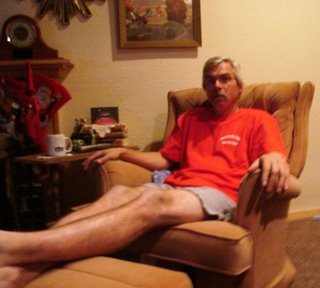 Greg did. Me too. We got ours from Wear Red on Fridays which is in our links.
Greg did. Me too. We got ours from Wear Red on Fridays which is in our links.See that photograph to the left of Greg, setting on top of some books? Greg is mentally working on a post about the object which is in the photo, the Blazer, the love of Aaron and Jerrod's teen years.
Of course, Tech is struggling, so we might give his post a day or two.
Happy Friday!
English: The Endangered Language
I was raised in a Spanish-speaking home by my grandparents who couldn't speak a lick of English. I love my culture, and I've always thought I enjoy the best of both worlds. I worked for one of Mexico City's largest daily newspapers as well as several papers in the United States. I'm glad I'm bilingual.
BUT. English should be the national language in this country. I've had a frustrating day dealing with tech support for the company that will host our new Web site, and I'm mighty exhausted. Not only should English be our national language, but it should be illegal for U.S. companies to outsource their tech support to other countries. By this time, we've all had a taste of trying to resolve a problem with someone in India or the Philippines.
We don't just bend over backwards in the United States to accomodate the speakers of other languages, we contort ourselves like pretzels trying to appease them. Who else does that? I've lived in Mexico, and I assure you that they don't. Their signs, official documents, etc. are all in Spanish, and if you have to go to court and don't speak their language, you're out of luck. They're not going to provide you with a translator as we do.
We're doing everything we can to make it easier for the immigrants while we make it more difficult for Americans. It's insane. And while I know it's not the same issue and U.S. companies are free to take their business anywhere, I would desperately like to discuss my technical problems with someone I can understand. After spending about five hours with tech support in the Philippines, I finally told the last guy I dealt with that I wanted to speak to someone in the United States. He told me the only people I could speak with in my own country would be the billing department. Oh, sure. That makes sense. The company doesn't care about the service I'm getting so they send my calls to another country. But if I want to talk about money, they're all ears. Geez.
I know I've fused two issues here, but they share a root. We keep engaging in practices that make it difficult for Americans to live and do business in our own country. So ... make English the national language and tell every company you deal with that you object to their customer support being directed to a Third World nation.
I'm glad I can speak Spanish, but I don't believe that I should have to use it to conduct business in the United States. And I don't believe that I should have to try to decipher what a customer service agent in another country is trying to tell me as he reads from a manual a litany of possible solutions to my problem.
I'm in America. Speak English.
Oh, we are working on our Web site, and I wanted to put up a simple paragraph that explains what we're doing. I finally figured out what the problem was, withouth the Philippino help. When De'on and I decided to launch a Web site for Gunz Up, I thought this hosting service would be an easy one. Yeah, sure. That's like looking at Mt. Everest and saying, "Oh, we can scale this one, no problem." The problem was that I couldn't log on to their FTP site. Each time I called tech support, I got a different solution. None of them worked. I had to figure it out on my own. I can now log on, so I shouldn't have any problem launching our Web site once it's finished next week.
It's been years since I've fiddled with HTML, but it's coming back to me. They've made advancements, of course, but they're good ones. I just have to build the site so that De'on can post without having to get a degree in HTML.
I'm sure no one cares about any of my complaints (!) but I feel better now after venting. Now back to the salt mines.
She Thanks and Encourages. Perseverance at it's finest!
I saw the blog you wrote about my book and I just wanted to thank you. That means a lot to me. It took me 8 years to get this book published, and it finally came out in August.
Yes, it is doing really well on Amazon, and it's all just been by word-of-mouth so you can see why I appreciate your blog.
I see you are a Gold Star Mother. I'm sorry for your loss.
Thank you again. I appreciate the sacrifice made by your family.
Stephanie
Stephanie Hanson Author of "A Corpsman's Legacy" www.acorpsmanslegacy.com
A Hot Night
Normally, Sarah runs and gets in front of their pet door when she knows it's time for them to eat. She didn't come this night. We called, hunted, drove, felt sick inside when we realized what must have happened. We even shook her dry food a few times, because that usually gets her out of hiding. In fact, to trick her away from the pet door, I go feed her first, though usually she runs back to the kitchen with me to terrorize Hen and Isaac some more.
Greg was upset. I couldn't believe it. She never wants to go out, and I've dealt with this one for 13 years.
Greg went to bed early and I started working on some posts when the Princess showed up at the well lit front door I'd left open for her. About 10:30, I heard a loud meoww at my door, and there she was. A little smelly, but came in the door just as unconcerned and unbothered as she must've been when she left nearly 24 hours earlier.
What a cat. She keeps things colorful around here. Thank you, Father, for bringing the tiny Christmas angel back home.
 All is well.
All is well.I'll be back with some of our military greats. Tonight's concentration will be on the Navy Corpsmen, tomorrow night, back to our Marines of 1st Marine Division until we get them out of Guadalcanal. Then it's LT Rich and our Seabees again, Guam with 4/12 ...see how it works?
Do I confuse you any? If so, please ask and I'll try to help figure it out. I think on the new site Steve is working on, each of the writers will have different archives, so that will help for sure. There'll be lots of new features and I can't wait for it to be up! The address will be easy to remember since it's the same as the blog. And we'll put a link up on this blog to direct you to the new one.
Steve will be coming here soon though he's in the blizzardy Panhandle still. We'll have a lot to look forward to this upcoming year and I really hope you join us.
I really do look forward to it.
Later ... and
Semper Fi,
De'on
I also want to let my cousin, Tonya, know we've had her mom, Shirley, in our thoughts and prayers. Shirley had open heart surgery.
Where I Write to You From

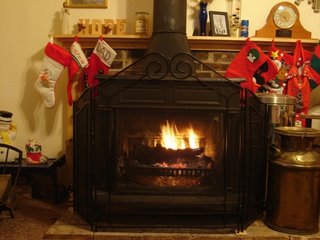
Weston was here the other night. You can barely see him, but you can see his elf hat on his head, there in my lap. He's looking at his picture on Gunz Up.
The fire is wonderful right now, and I hope you're as cozy as I am. Much thanks to hubby, to Aaron, and to the Father that I am allowed to heal in such peaceful surroundings.
I'm happy here. But not up for the world yet. That works for me.
Oh yeah, I look like I have a turtle face, huh?
Ellf caps, Bubbles and Axel

Weston is in the elf stocking cap that I stuff every year. Jess, you need to bring my stocking back to me.
Weston was determined to take it, as well as Axel home with him. Axel is the black bear I got him for Christmas. The black bear's T-shirt says Nomi and Uncle Greg love me the most.
Axel, who runs about $3. per inch is the perfect snuggle bear. For $6. per inch, I could've had him here on time. Bargains galore on the final shopping days, don't you think?
Axel is precious. And Weston wanted a teddy bear to sleep with. It came at a good time. Bubbles, Weston's goldfish with lipstick and a halo, "the little girl, " Mimi called her, swam into the filter of the aquarium.
Bubbles was buried at sea.
According to Weston, she went to Heaven. I think he's right.
P.S. Meet Axel. I don't have a photo of him. Not sure about our photographer this year!
A Final Look ...probably

Don't take the tree
down
please not yet.
I'm sorry gifts didn't
snuggle here. A train
the colors of Christmas
broken still,
from last year.
Two thousand four
slipped down
my chimney, smoked
my eyes, choked my
heart. But still, I stoked it.
Tiny angels of light
on the tree of O six
guard my hope late at night.
Ghosts of Christmases past
visit here, maybe they watch
as I write.
Don't take down the Christmas tree.
A New Web Site For Gunz Up
With our new site, we hope to stir up patriotism and encourage our fellow Americans to display their national pride openly. Our country needs that energy now. The men and women who defend us need to see and feel our support. With that in mind, we have been working on a Web site that will work with others to fuel a love for the United States -- the greatest country in the world.
Chief of Naval OPS in Bahrain

Friday, December 29, 2006
061227-N-9594C-003 Manama, Bahrain (Dec. 27, 2006) - Chief of Naval Operations (CNO) Adm. Mike Mullen addresses Sailors and Marines on board Naval Support Activity Bahrain during a holiday tour of U.S. Naval Forces Central Command area of operations (AOO). During their stop in Bahrain, the CNO and Master Chief Petty Officer of the Navy (MCPON) Joe R. Campa Jr. addressed Sailors' issues and expressed gratitude for the Sailors' service during an all hands call. U.S. Navy Photo by Chief Mass Communication Specialist Julian Carroll (RELEASED)
***
Aaron deployed for OIF 1 on the USS Rushmore. After they left Kuwait to head back, they spent quite a bit of time in Bahrain.
Navy Numbers
American Forces Press Service
As of the end of September 2006 more than 11,000 sailors are deployed at sea in the Middle East, and 12,000 sailors are deployed in U.S. Central Command countries, said Navy Lt. Trey Brown, a Navy spokesman. About 4,300 sailors are on the ground in Iraq, he said.
The Navy has lost 56 sailors in Operation Iraqi Freedom and 29 in Operation Enduring Freedom.
Many sailors who deploy to Iraq and Afghanistan go as “individual augmentees,” which means they are pulled from their home units to support the war on terror, Brown said. The 520 sailors coming back from Iraq this week, for example, are from more than 100 different Navy commands.
Every sailor sent to the Middle East goes through specialized training to prepare for the mission, Brown said. The level of training depends on the mission they will perform, he said. Those who will be in a staff position do two weeks of weapons and cultural training at Fort Jackson, S.C., and the sailors who work with detainees go through three months of training, he said.
In Afghanistan, about 180 sailors are working on six provincial reconstruction teams working directly with the provinces, teaching the leaders how to work with the national government and local governments, he said.
The numbers of sailors on the ground has increased continually since the start of Operation Enduring Freedom in Afghanistan, and has steadily grown to its current strength, Brown said. Future levels will depend on the requirements of the commanders on the ground, he said, but he added that he expects the Navy to continue to be a valuable contributor to the war on terror. “Certainly we anticipate that our sailors are going to continue to be in high demand; the skills that we have will continue to be wanted over there,” he said.
Question: This article is from September. Have the numbers changed?
To Be ... A Political Map of Iraq 2004
To Be ... snapping photos from a rooftop in Iraq
 Rich e-mails his sister, Karen, on Oct.22, 2005: "Here's one looking from the rooftop of where we stayed. It was a half bombed out building that we shared with the special op guys. You can see our showers below (white stuctures). All the trees in the distance is the Euphrates River and where the bad guys lobbed mortars at us from."
Rich e-mails his sister, Karen, on Oct.22, 2005: "Here's one looking from the rooftop of where we stayed. It was a half bombed out building that we shared with the special op guys. You can see our showers below (white stuctures). All the trees in the distance is the Euphrates River and where the bad guys lobbed mortars at us from."Questions for LT Rich:
1. Where exactly was this Rich?
2. When you say special ops, who exactly are you referring to?
3. How many were quartered here?
To Be ... "Oh, Lord,Won't You Buy Me A Mercedes Benz?"

1. What year model was the Mercedes?
To Be ... OIC
To Be ... SOP
Anyway, I'm assuming that's a 9 mm LT. Windham is checking out inside his quarters in Iraq while he was stationed there for 6 months during 2005, 2006.
 Questions for LT Rich:
Questions for LT Rich:1. Is a 9 mm standard issue for all officers in the Navy? I know it was in the Army.
2. Where do you keep it strapped to your body at when you're out?
3. Do you always have both weapons on you, or just at certain times? I'm talking strictly about serving in a combat zone. What is the SOP?
4. Any others?To Be ... Two Two in ...
Haditha, Iraq (Nov. 28, 2005) - U.S. Navy Steelworker 2nd Class Jesus Cepeda, left, explains how to control an air conditioner to an Iraqi Security Force (ISF) soldier at an ISF camp. Cepeda is assigned to Naval Mobile Construction Battalion Two Two (NMCB-22) a reserve battalion headquartered in Fort Worth, Texas, activated in July in support of the global war on terrorism.
U.S. Navy photo by Journalist 1st Class Leslie A. Shively (RELEASED)

 051128-N-3750S-269 Haditha, Iraq (Nov. 28, 2005) - U.S. Navy Equipment Operator 3rd Class Michael Martin, left, hands Steelworker 2nd Class Jesus Cepeda the tools he needs to continue installing an air conditioner at an Iraqi Security Force (ISF) camp. Martin and Cepeda are assigned to Naval Mobile Construction Battalion Two Two (NMCB-22) a reserve battalion headquartered in Fort Worth, Texas, activated in July in support of the global war on terrorism. U.S. Navy photo by Journalist 1st Class Leslie A. Shively (RELEASED)
051128-N-3750S-269 Haditha, Iraq (Nov. 28, 2005) - U.S. Navy Equipment Operator 3rd Class Michael Martin, left, hands Steelworker 2nd Class Jesus Cepeda the tools he needs to continue installing an air conditioner at an Iraqi Security Force (ISF) camp. Martin and Cepeda are assigned to Naval Mobile Construction Battalion Two Two (NMCB-22) a reserve battalion headquartered in Fort Worth, Texas, activated in July in support of the global war on terrorism. U.S. Navy photo by Journalist 1st Class Leslie A. Shively (RELEASED)Source for full story.
To Be ... Lonestar "22" History
Naval Construction Battalion Twenty Two (NCB-22) was initially commissioned on September 2, 1942 at the Seabee Training Center, camp Allen, Norfolk, Virginia. After advance military and technical training at Port Hueneme, California. NCB-22 arrived at its assigned duty station at Sitka, Alaska on November 28, 1942. While there, the battalion completed a total of 28 projects in seven months.
On July 6, 1943, TWENTY TWO moved farther west to Attu, an island of tundra and windswept mountains in the Aleutian chain. Two months earlier, U.S. Army units had captured the island from the Japanese. The Seabees' primary task was to build an airfield for U.S. Bombers. The airstrip work began on July 16 with men working 24 hour day basis in violent, unpredictable weather. After eleven days of constant work, "Twenty Two" completed the first usable section of runway. Before the winter approached, two 5,000 foot runways were in operation. At the same time, the Seabees had built hangers, Quonset hunts, and a PT boat dock.
On March 14, 1944 Naval Construction Battalion Twenty Two "The Famous 22nd" departed Attu for Camp Parks, Shoemaker, California where she was decommissioned.
Reserve Naval Mobile Construction Battalion TWENTY TWO (RNMCB 22) was re-established on March 5, 1961. During Phase I of the Battalion's organizational training conducted at the Battalion Construction Center, Davisville, Rhode Island in 1961, the Battalion selected the name Lone Star Battalion. At the time, only Texas Seabee reservists were assigned to RNMCB 22 and its emblem was the state outline. Later reservists from Arkansas, Louisiana, Oklahoma, and New Mexico were assigned to the battalion. The Battalion emblem was changed include all five states joined together as one solid block which symbolized the strength of the battalion. The Lone Star Battalion was awarded the RADM John R. Perry Trophy on November 5, 1967 at ceremonies conducted at Naval Air Station Dallas, Texas. This award is named in honor of the late Rear Admiral John R. Perry, CEC, USN. It was originated by the Bureau of Yards and Docks, approved by the Secretary of the Navy on July 22, 1964, and is awarded annually to the top reserve battalion in the country. At the time, RNMCB 22 was only the second battalion to received the award.
Twelve days after release from Active Duty for Training at Camp Lejeune in 1968, RNMCB 22 received notice of "that long training duty", we were recalled to Active Duty. The battalion reported for mobilization to Construction Battalion Center, Gulfport, Mississippi on May 13, 1968. Upon commissioning RNMCB 22 became Mobile Construction Battalion TWENTY TWO (MCB 22). The Advance Party of MCB 22 deployed for Viet Nam in July of 1968 with the Main Body arriving in August 1968.
Serving under the THIRD Naval Construction Brigade while in Viet Nam, the Lone Star Battalion was awarded the Navy Unit Commendation and the Meritorious Unit Commendation by the Secretary of the Navy for outstanding service. While in Viet Nam "22" established records in the field of construction that remain unsurpassed and received the title "The Professionals." It proved the worth of maintaining a Reserve Naval Mobile Construction Battalion as part of the Navy's "TOTAL FORCE IN READINESS".
In 1990 the Lone Star Battalion was again notified to prepare for recall in support of Operation Desert Shield/Desert Storm. Due to early end of the operation the battalion was ordered to stand down and while deployed for training at CBC Port Hueneme, California the battalion was re-designated as Naval Mobile Construction Battalion TWENTY TWO (NMCB 22) signifying the integrated Active/Reserve Naval Construction Force. In October 1991 the battalion was again awarded the Admiral John R. Perry Trophy as "Best of Type" in the RNCF then in 1992 NMCB 22 was recognized as "Best of Type" in THIRD Naval Construction Brigade.
The Lone Star Battalion is still one of the top reserve units in the nation and is composed of detachments located in Texas, New Mexico, and Oklahoma. The battalion portrays a large star containing the outline of the states of Texas, New Mexico, and Oklahoma. During Fiscal Year 1997, NMCB-22 relocated its Ready Reserve Site (RSS) to NAS JRB Ft Worth, TX. In July 1997, "22" participated in Operation Ready Bee at Camp Bullis, San Antonio, TX, Operation Green Stinger, NAS Dallas, TX, and Operation Bearing Duel at Fort Hunter-Liggett, CA. The success of these missions was shown by NMCB-22 being awarded the Battle "E" and Best of Type in THIRD Naval Construction Brigade for Fiscal Year 1997.
Once again "22" has lived up to her reputation, being chosen as reserve battalion Battle "E" winner for Fiscal Year 1999. Through an aggressive and effective military Training Program all readiness goals were met while serving as Prime contractor on a joint reserve-active project we planned and completed a 3,000 square foot two story Pre-Engineered Building with outstanding results. "22's" CESE's management program received the highest marks in the Reserve Naval Construction Force.
Copied then colored from source
Thursday, December 28, 2006
Photo of the Day: Looking Up
A Corpsman's Legacy: New Release
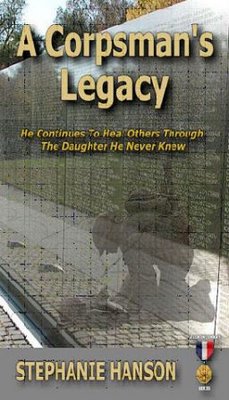
This is the touching story of a young lady's search for her biological father. It is also a compelling story of the Marines who took in Stephanie as one of their own because her father was a Navy Corpsman. There is no person more respected and loved by Marines than their "Doc" - their Corpsman who shares the hardship and misery of combat to save Marine lives, sometimes sacrificing their own. Stephanie's dad is a true hero to all of us who wore the Marine uniform.
LtGen Michael A Hough, USMC (Ret)
Former Deputy Commandant for Aviation
***
I ran across this book the other night on the web, so I went searching for it tonight. It's a new release from Leatherneck Publishing, and evidently is doing quite well, because Amazon.com only has 4 new books left, but used are available with another shipment due later in January.
The good news is, Leatherneck ships within 72 hours.
Check out Leatherneck Publishing's site for yourself.
Signs and Feelings
Our Lord, Thou art here. Let us feel Thy nearness.
I AM here. Do not need feeling too much. To ask for feeling too much is to ask for a sign, and then the answer is the same as that I gave when on earth. "There shall no sign be given but the sign of the prophet Jonas.... For as Jonas was three days and three nights ... so shall the Son of Man be three days and three nights in the heart of the earth."
Veiled from sight to the unbeliever. To the believer the veiling is only temporary, to be followed by a glorious resurrection....
What does it matter what you feel? What matters is what I am, was, and ever shall be to you--A Risen Lord.... The feeling that I am with you may depend upon any passing mood of yours--upon a change of circumstances, upon a mere trifle.
I am uninfluenced by circumstances.... My Promise given is kept. I am here, one with you in tender loving friendship.
Russell, A. J., ed. God Calling. Barnes & Noble, 2002.
Virgie Bell's View
There's a post office here in my hometown with his name on the front. It's just a small plaque mentioning him as being president at the time of its construction. I learned more about his time as our nation’s leader yesterday than I've ever known before.
I also remember the convention where he was running for office, but what stayed in my mind then was his wife dancing quite inappropriately. We found out later she'd been under the influence of alcohol or medication. She went on to become one of the most influential and positive forces in that regard than we've ever known, and the United States is indebted to her for the positive position she retains as her legacy to a grateful nation. Mrs. Ford was also a great force in bringing breast cancer to the forefront. That too is positive, but in reading about President Ford's assessment of the battle of terror being fought in the killing fields of Iraq (an interview with the writer Bob Woodward that was captured on a four hour tape), he made the remark that had he been President at the time of the tragedy, he would have avoided going to war.
We did not go to war. War came to us in the most chilling un-unexpected way. We reacted to this attack in the only way possible--to take a war to the enemy. My God, the former president was in favor of sanctions. OK, we were all for that. Instead we were being bilked in the oil for food program. The UN has helped to make us a laughing stock around the world.
Saddam Hussein was a monster. He is a monster. Will be until he swings on the gallows. I only have a minute to post today as I am scheduled for surgery, but I will say this much: I am glad Gerald Ford was not president on the day war was declared on us and we answered in kind. I'm glad Jimmy Carter wasn’t either. I'm relieved we had, and have, a president who SUPPORTS OUR TROOPS.
General Alexander A. Vandegrift
The man destined to lead the 1st Marine Division in America's first ground offensive operation of World War II was born in 1887 in Charlottesville, Virginia, where he grew up fascinated by his grandfather's stories of life in the Confederate Army during the Civil War. It was axiomatic that young Alexander would settle on a military career. Commissioned a Marine lieutenant in 1909, Vandegrift received an early baptism of fire in 1912 during the bombardment, assault, and capture of Coyotepe in Nicaragua. Two years later he participated in the capture and occupation of Vera Cruz. Vandegrift would spend the greater part of the next decade in Haiti, where he fought Caco bandits, and served as a inspector of constabulary with the Gendarmerie d'Haiti. It was in Haiti that he met and was befriended by Marine Colonel Smedley D. Butler, who called him "Sunny Jim." The lessons of these formative years fighting an elusive enemy in a hostile jungle environment were not lost upon the young Marine officer.
He spent the next 18 years in various posts and stations in the United States, along with two tours of China duty at Peiping and Tientsin. Prior to Pearl Harbor, Vandegrift was appointed assistant to the Major General Commandant, and in April 1940 received the single star of a brigadier general. He was detached to the 1st Marine Division in November 1941, and in May 1942 sailed for the South Pacific as commanding general of the first Marine division ever to leave the United States. On 7 August 1942, after exhorting his Marines with the reminder that "God favors the bold and strong of heart," he led the 1st Marine Division ashore in the Solomons Islands in the first large-scale offensive action against the Japanese.
His triumph at Guadalcanal earned General Vandegrift the Medal of Honor, the Navy Cross, and the praise of a grateful nation. In July 1943 he took command of I Marine Amphibious Corps and planned the landing at Empress Augusta Bay, Bougainville, Northern Solomons, on 1 November 1943. He then was recalled to Washington, to become the Eighteenth Commandant of the Marine Corps.
On 1 January 1944, as a lieutenant general, Vandegrift was sworn in as Commandant. On 4 April 1945 he was promoted to general, and thus became the first Marine officer on active duty to attain four-star rank.
On 1 January 1944, as a lieutenant general, Vandegrift was sworn in as Commandant. On 4 April 1945 he was promoted to general, and thus .
In the final stages of the war, General Vandegrift directed an elite force approaching half-a-million men and women, with its own aviation force. Comparing his Marines with the Japanese, he noted that the Japanese soldier "was trained to go to a place, stay there, fight and die. We train our men to go to a place, fight to win, and to live. I can assure you, it is a better theory."
After the war, Vandegrift fought another battle, this time in the halls of Congress, with the stakes being the survival of the Marine Corps. His counter-testimony during Congressional hearings of the spring of 1946 was instrumental in defeating initial attempts to merge or "unify" the U.S. Armed Forces. Although his term as Commandant ended on 31 December 1947, General Vandegrift would live to see passage of Public Law 416, which preserved the Corps and its historic mission. His official retirement date of 1 April 1949 ended just over 40 years of service.
General Vandegrift outlived both his wife Mildred and their only son, Colonel Alexander A. Vandegrift, Jr., who fought in World War II and Korea. He spent most of his final years in Delray, Florida. He died on 8 May 1973. —Robert V. Aquilina
Blood Is Thicker Than Water: The Marine Campaign for Guadalcanal
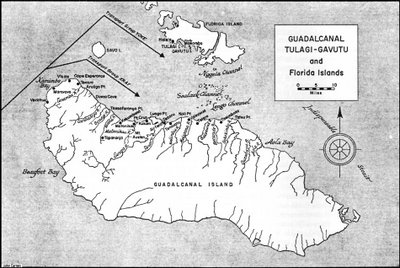 on the last post we finished up with the introduction. This is part one of the :
on the last post we finished up with the introduction. This is part one of the :FIRST OFFENSIVE: The Marine Campaign for Guadalcanal
by Henry I. Shaw, Jr.
The Landing and August Battles
On board the transports approaching the Solomons,
The Marines were looking for a tough fight. They knew little about the targets, even less about their opponents. Those maps that were available were poor, constructions based upon outdated hydrographic charts and information provided by former island residents. While maps based on aerial photographs had been prepared they were misplaced by the Navy in Auckland, New Zealand, and never got to the Marines at Wellington.
On 17 July, a couple of division staff officers, Lieutenant Colonel Merrill B. Twining and Major William McKean, had been able to join the crew of a B-17 flying from Port Moresby on a reconnaissance mission over Guadalcanal. They reported what they had seen, and their analysis, coupled with aerial photographs, indicated no extensive defenses along the beaches of Guadalcanal's north shore.
This news was indeed welcome. The division intelligence officer (G-2), Lieutenant Colonel Frank B. Goettge, had concluded that about 8,400 Japanese occupied Guadalcanal and Tulagi. Admiral Turner's staff figured that the Japanese amounted to 7,125 men. Admiral Ghormley's intelligence officer pegged the enemy strength at 3,100—closest to the 3,457 actual total of Japanese troops; 2,571 of these were stationed on Guadalcanal and were mostly laborers working on the airfield.
To oppose the Japanese, the Marines had an overwhelming superiority of men. At the time, the tables of organization for a Marine Corps division indicated a total of 19,514 officers and enlisted men, including naval medical and engineer (Seabee) units. Infantry regiments numbered 3,168 and consisted of a headquarters company, a weapons company, and three battalions. Each infantry battalion (933 Marines) was organized into a headquarters company (89), a weapons company (273), and three rifle companies (183). The artillery regiment had 2,581 officers and men organized into three 75mm pack howitzer battalions and one 105mm howitzer battalion. A light tank battalion, a special weapons battalion of antiaircraft and antitank guns, and a parachute battalion added combat power. An engineer regiment (2,452 Marines) with battalions of engineers, pioneers, and Seabees, provided a hefty combat and service element. The total was rounded out by division headquarters battalion's headquarters, signal, and military police companies and the division's service troops—service, motor transport, amphibian tractor, and medical battalions. For Watchtower, the 1st Raider Battalion and the 3d Defense Battalion had been added to Vandegrift's command to provide more infantrymen and much needed coast defense and antiaircraft guns and crews.
Unfortunately, the division's heaviest ordnance had been left behind in New Zealand. Limited ships' space and time meant that the division's big guns, a 155mm howitzer battalion, and all the motor transport battalion's two-and-a-half-ton trucks were not loaded. Colonel Pedro A. del Valle, commanding the 11th Marines, was unhappy at the loss of his heavy howitzers and equally distressed that essential sound and flash-ranging equipment necessary for effective counterbattery fire was left behind. Also failing to make the cut in the battle for shipping space, were all spare clothing, bedding rolls, and supplies necessary to support the reinforced division beyond 60 days of combat. Ten days supply of ammunition for each of the division's weapons remained in New Zealand.
to be continued.
Click here for the source this was COPIED from.
First Marine Utility Uniform Issued in World War II
As had the Army, the Marine Corps had used a loose-fitting blue denim fatigue uniform for work details and some field exercises since the 1920s. This fatigue uniform was either a one-piece coverall or a two-piece bib overall and jacket, both with "USMC" metal buttons. In June 1940, it was replaced by a green cotton coverall. This uniform and the summer field uniform were replaced by what would become known as the utility uniform. Approved for general issues on the Marine Corps' 166th birthday, 10 November 1941, this new uniform was made of sage-green (although "olive drab" was called for in the specifications) herring-bone twill cotton, then a popular material for civilian work clothing. The two-piece uniform consisted of a coat (often referred to as a "jacket" by Marines) and trousers. In 1943, a cap made of the same material would be issued.
The loose-fitting coat was closed down the front by four two-piece rivetted bronze-finished steel buttons, each bearing the words "U.S. MARINE CORPS" in relief. The cuffs were closed by similar buttons. Two large patch pockets were sewn on the front skirts of the jacket and a single patch pocket was stitched to the left breast. This pocket had the Marine Corps eagle, globe, and anchor insignia and the letters "USMC" stencilled on it in black ink. The trousers, worn with and without the khaki canvas leggings, had two slashed front pockets and two rear patch pockets.
The new uniform was issued to the flood of new recruits crowding the recruit depots in the early months of 1942 and was first worn in combat during the landings on Guadalcanal in August 1942. This uniform was subsequently worn by Marines of all arms from the Solomons Campaign to the end of the war. Originally, the buttons on the coat and the trousers were all copper-plated, but an emergency alternate specification was approved on 15 August 1942, eight days after the landing on Guadalcanal, which allowed for a variety of finishes on the buttons. Towards the end of the war, a new "modified" utility uniform which had been developed after Tarawa was also issued, in addition to a variety of camouflage uniforms. All of these utility uniforms, along with Army-designed M1 helmets and Marine Corps-designed cord and rubber-soled rough-side-out leather "boondocker" shoes, would be worn throughout the war in the Pacific, during the postwar years, and into the Korean War.—Kenneth L. Smith-Christmas
To Be ... MCB-6 Through the Years

The photo to the left is captioned:
Cmdr. Joseph Blundon, SIX's first CO, peers out of his "office" on Guadalcanal during World War II.
***
From the bloody beaches of Guadalcanal to the jungles of Vietnam, U.S. Naval Mobile Construction Battalion SIX has upheld the Seabee motto - "Can Do!" The first Seabee battalion to work under actual combat conditions was Naval Construction Battalion SIX.
This unit went ashore with the Marines on Guadalcanal in 1942 under the command of Cmdr. Joseph P. Blundon. From. Aug. 7 to Dec. 9,-1942, NCB SIX fought beside, and built reinforced positions for, the first Marine Division. During this period, the men of NCB SIX worked as combat engineers, aviation engineers, and construction engineers 24 hours a day.
For the heroic efforts of 6th Naval Construction Battalion under fire, the battalion earned the Presidential Unit Citation. After building and fighting on Guadalcanal, Espiritu Santo, Tulagi, Auckland, Noumea and Okinawa, 6th Naval Construction Battalion was decommissioned in October of 1945.
Six years later America again needed military construction units which could fight as well as build, so the NCBs were reactivated. On May 3, 1951, 6th Naval Construction Battalion was recommissioned as Mobile Construction Battalion SIX under the command of Cmdr. R. D. Pinkerton in Norfolk, Va.
The change from NCB to MCB was in accordance with. a 1949 order by the Chief of Naval Operations designed to emphasize the mobility of the Navy's Construction Battalions. Upon being recommissioned in 1951, Mobile Construction Battalion SIX became the only Seabee battalion in commission entitled to display the Presidential Unit Citation.
To Be ... Commander Joseph P. Blundon
this post is copied from The Pacific War Forum
Can-Do at Guadalcanal - The Seabee story of Guadalcanal begins on the afternoon of August 20, 1942, when 45 year old Commander Joseph P. (CEC, USNR) arrived in a PBY off Lunga Point and promptly reported to General A.A. Vandergrift. I guess I was the first Seabee to go under fire, Commander Blundon recalled. The Marines had been on Guadalcanal thirteen days, and they had a tiny beachhead around Henderson Field. While I was reporting to General Vandergrift the Jap bombers came over and I hit my first foxhole. A few days later my Sixth Seabee Battalion arrived, and we assumed full responsibility for the completion and maintenance of Henderson Field. The Japs had cleared an area 300 by 5600 feet, but it was by no means finished. The Japs were shelling the field with Howitzers, as well as bombing it night and day, and it was our job to keep the holes filled up while we finished the grading, laid Marston mat, built hardstands and revetments, and helped solve the fuel and ammunition problems. We had very little equipment, General Vandergrift assigned us a section of the beach to defend against the Jap landings, and we figured we could defend the beach and still do the job at Henderson Field. We realized at the outset that the battle was going to turn on how fast we filled up holes and how fast we could develop that field. When the Jap bombers approached, our fighters took off, the bombers blasted the airstrips, and then if we couldn't fill up those holes before our planes ran out of fuel, the planes would have to attempt to land anyway, and they would crash. I saw seven of our fighters crack up in one bitter afternoon. From "our" point of view the battle of Guadalcanal was a race between the Jap artillery and the air force and the Sixth Seabee Battalion. We played our cards fast. We pitched our camp at the edge of the field to save time. We dug our foxholes right up alongside the landing area. We found that a 500 pound bomb would tear up 1600 square feet of Marstom Mat, so we placed packages of this quantity of mat along the strip, like extra rails along a railroad. We figured out how much sand and gravel was required to fill the average bomb or shell crater, and we loaded these measured amounts on trucks and placed the trucks under cover at strategic points. We had compressors and pneumatic hammers to pack the fill into the craters. We organized human assembly lines for passing up the pierced plank and laying it. Then when the Jap bombers approached, every Seabee including even our cooks, manned his repair station. Our crater crews were lying in the foxholes right at the edge of the strip. The moment the bombers had passed over, these men boiled out of the holes and raced for the craters. Every man had to keep his eye peeled for Jap strafing planes, and when the Jap dived in, our men dived for the close at hand foxholes. We found that 100 Seabees could repair the damage of a 500-pound bomb hit on an airstrip on forty minutes. In twenty four hours on October 13 and 14, fifty-three bomb and shells hit the Henderson airstrip. During one hour on the 14th we filled thirteen bomb craters while our planes circled overhead waiting to land. In the period from September 1, to November 18, we had 140 Jap raids in which the strip was hit at least once. Our worst moments were when the Jap bomb or shell failed to explode when it hit. It still tore up our mat, and it had to come out. "When you see men choke down their fear and dive in after an unexploded bomb so that our planes can land safely, a lump comes in your throat and you know why America wins wars". Shell craters are more dangerous to work on than bomb craters. You have a feeling that no two bombs ever hit in the same place, but this isn't true of shells. A Jap five-inch gun lobs a shell over on your airstrip and blasts a helluva hole. What are you going to do? You know, just as the that Jap artillery man knows, that if he leaves his gun in the same position and fires another shell, the second shell will hit in almost the same spot as the first one. So a good old Jap trick was to give us enough time to start repairing the hole and then fire the second shell. All you can do is depend on hearing that second shell coming and hope you can scramble far enough away before it explodes. But this is a gamble which is frowned upon by life insurance companies.
Info in crayon is testable.
The 63rd Seabees is linked. I liked it too. No testing from it though.



